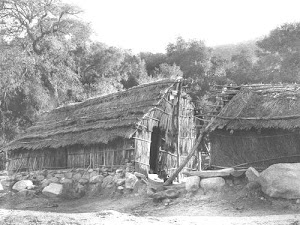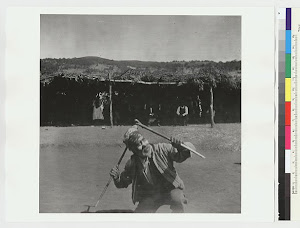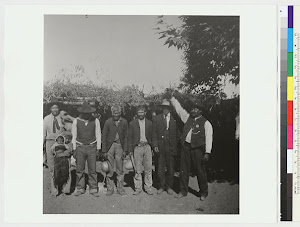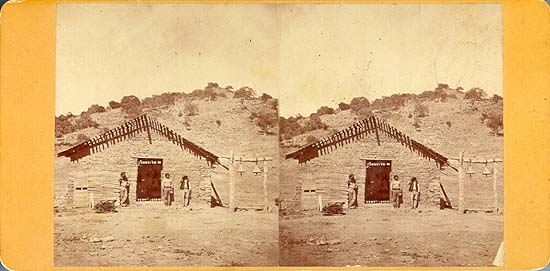NATIONAL LIBRARY OF MEDICINE OPENS NEW INTERACTIVE EXHIBITION
Native Voices: Native Peoples' Concepts of Health and Illness first of its kind
A new exhibition examining concepts of health and medicine among contemporary American Indians, Alaska Natives, and Native Hawaiians, is opening at the National Library of Medicine, part of the National Institutes of Health. Native Voices: Native Peoples' Concepts of Health and Illness, explores the connection between wellness, illness, and cultural life through a combination of interviews with Native people, artwork, objects, and interactive media.
Opening events will be held Oct. 5, 2011 and will include ceremonial dancing and the blessing of a healing totem pole that was created for the exhibition and installed in front of the Library. The program will begin at 10:30 a.m. in the auditorium of the Lister Hill Center (Building 38A) on the NIH campus in Bethesda, Md. At 11:45 a.m., events move to the front of the Library (Building 38) for the blessing of the healing totem pole and the exhibition, and for the exhibition ribbon-cutting. Native Voices opens to the public Oct. 6.
The National Library of Medicine has a history of working with Native communities as part of the Library's commitment to make health information resources accessible to people no matter where they live or work. The Native Voices exhibition concept grew out of meetings with Native leaders in Alaska, Hawaii and the contiguous United States.
"This exhibition honors the Native tradition of oral history and establishes a unique collection of information," says Donald A.B. Lindberg, MD, director of the National Library of Medicine. "We hope visitors will find Native Voices educational and inspirational, and we hope Native people will view it with pride. The Library is excited to open this exhibition, and to do it during our 175th anniversary year."
Topics featured in the exhibition include: Native views of land, food, community, earth/nature, and spirituality as they relate to Native health; the relationship between traditional healing and Western medicine in Native communities; economic and cultural issues that affect the health of Native communities; efforts by Native communities to improve health conditions; and the role of Native Americans in military service and healing support for returning Native veterans.
In addition to the collection of interviews, here are some of the objects visitors will find in the exhibition:
-- In the lobby of the Library, guiding people into the exhibition, is a 10-foot model of the Hokule'a, a traditional Hawaiian voyaging canoe used for long-distance travel. Visitors will learn how the mission of the Hokule'a has spurred a Hawaiian cultural and health revival.
-- Inside the exhibition, in a section that explores Native games for survival, strength and sports, visitors will find a vintage surfboard and learn about Native Hawaiian sportsman Duke Kahanamoku, who won Olympic medals in swimming and revived the sport of surfboarding.
-- Ceremonial drums, pipes, and rattles from the Upper Plains Indians grace a section on healing.
-- A World War II radio is one object that helps tell the story of Navajo and other American Indian Code Talkers. Visitors will learn about their service to the country and the ceremonies performed by traditional healers to help relieve combat-related stress experienced by returning veterans.
-- The 20-foot healing totem pole created by master carver Jewell Praying Wolf James and the House of Tears Carvers of the Lummi Nation in the Pacific Northwest is located in the herb garden in front of the Library. Visitors will discover the meaning of the stories, symbols and colors on the totem pole and two benches that accompany it. In the weeks preceding the exhibition opening, the totem received blessings from a number of tribes as it was transported across the country to be permanently installed at the Library. Previous work by carver Jewell James includes healing totems to honor the victims of the September 11th attacks. Those totems are now installed in Arrow Park in New York, in Shanksville, Pennsylvania and at the Congressional Cemetery in Washington, DC.
To make the Native Voices information accessible to people who can't come to the Library, there is an online version of the exhibition at www.nlm.nih.gov/nativevoices . The Library hopes to develop a travelling version consisting of a series of banners with information.
For people interested in Native health issues in general, the Library's collection of free online information contains material on Native health including:
-- An American Indian Health portal to issues affecting the health and well being of American Indians (http://americanindianhealth.nlm.nih.gov/)
-- An Arctic Health website with information on diverse aspects of the Arctic environment and health of northern peoples (http://www.arctichealth.org/)
-- A Native American Health page on MedlinePlus.gov, the Library's consumer health website (http://www.nlm.nih.gov/medlineplus/nativeamericanhealth.html)
For the media
Please contact Kathy Cravedi (cravedik@mail.nlm.nih.gov and 301-496-6308) or Melanie Modlin (mm3541@nih.gov and 301-496-7771) at the National Library of Medicine for access to the following resources available in advance to members of the media.
-- By-appointment preview tours of the exhibition 10 a.m-4 p.m., Monday, Oct. 3, 2011.
-- Thumbnails of images from the exhibition.
-- Video of healing totem blessings available upon request.
-- Availability of key NLM staff and individuals associated with the exhibition for interviews before, during and after the opening event.
The opening program, with captioning, will be available as a live videocast at
The National Library of Medicine (NLM) is the world's largest library of the health sciences and collects, organizes and makes available biomedical science information to scientists, health professionals and the public. It is celebrating its 175th anniversary in 2011. For more information, visit the website at
About the National Institutes of Health (NIH): NIH, the nation's medical research agency, includes 27 Institutes and Centers and is a component of the U.S. Department of Health and Human Services. NIH is the primary federal agency conducting and supporting basic, clinical, and translational medical research, and is investigating the causes, treatments, and cures for both common and rare diseases. For more information about NIH and its programs, visit
##
This NIH News Release is available online at:
Monday, September 26, 2011
Native Voices: Native Peoples' Concepts of Health and Illness
Posted by
Karen Vigneault Librarian
at
9:21 AM
0
comments
![]()
Friday, September 23, 2011
a book with no English has been chosen as a Best Read for 2011

National Book Festival to celebrate books, authors, illustrators and publishers from all 50 states, they may hear something quite different from the usual readings—the Ojibwe language.
For the first time, a book with no English has been chosen as a Best Read for 2011, selected by each state and the District of Columbia. That thrills Anton Treuer, co-editor and one of the writers of Awesiinyensag: Dibaajimowinan Ji-gikinoo’amaageng (Wiigwaas Press, 2011), a young reader Ojibwe-language book.
In the book, 12 writers, co-editor Jim Cihlar and Ojibwe illustrator Wesley Ballinger depict animals playfully dealing with situations that will resonate with children from just about any culture, according to the publisher. It’s the first in a series planned by the imprint, which was started in 2008 by American Indian authors Heid and Louise Erdrich to promote learning the Ojibwe language, Anishinaabemowin.
Heid Erdrich said Ballinger’s artwork “makes the book enjoyable for those who don’t read Ojibwe and understandable for those who are beginners in the language, like me.”
It is pioneering in other ways, too.
“As far as I know, this is the first time that a non-English book has been chosen by a state. I do think that there have been a couple of dual-language books chosen,” said John Y. Cole, director of the Library of Congress’s Center for the Book, which sponsors the annual event.
“I think it’s great that anyone who wants to read Minnesota’s best book in 2011 has to do it in Ojibwe!” said Treuer, the Bemidji State University Professor of Ojibwe and co-editor of the series of original stories inspired by Ojibwe elders and speakers. A prodigious author himself, he wrote two English-language books, published last year, that were based largely on oral histories gathered directly from Ojibwe speakers over the course of several years.
“It’s exciting,” agreed Heid Erdrich. “It was really blessed, completely blessed. We’d just put the next [Ojibwe language] book to the printers.”
The book was created especially for use in Ojibwe immersion language schools. All the stories are new, original tales for children, based on conversations with elders and fluent Anishinaabemowin speakers. The book uses regional dialects, so there is a broad representation of variations within the Ojibwe language.
Each state, through its own affiliate of the Center for the Book, chooses a book to represent it at the festival. The free, public festival is organized and sponsored by the Library of Congress and will run from 10 a.m. to 5:30 p.m. on Saturday September 24 and Sunday, September 25 from one to 5:30 p.m.
The Ojibwe book will be among thousands of titles at the festival, where more than 100 authors, illustrators and poets will present their work on the National Mall at pavilions for Fiction & Mystery, History & Biography, Contemporary Life, Poetry & Prose, Children and Teens, according to the festival site. There will also be a Family Storytelling Stage, and, on Sunday, the Cutting Edge, State Poets Laureate and Graphic Novels will be presented at the Pavilion of the States.
“We try to pick books that are going to make people think a little differently about books … and to show that Minnesota is kind of a unique place,” said Matthew Brandt, vice president of the Minnesota Humanities Center and Minnesota’s Center for the Book, which nominated Awesiinyensag, adding that the goal is “to be a little different and to teach through the selection of the book, or to learn together.”
Besides representation from each state, the National Book Festival attracts a variety of publishers, authors and illustrators with areas specific to certain genres. Award-winning author Sherman Alexie will attend the festival for the first time, featuring his newest book, War Dances.
Posted by
Karen Vigneault Librarian
at
9:04 AM
0
comments
![]()
Monday, September 19, 2011
INTERNATIONAL OBSERVE THE MOON NIGHT
HOWKA TRIBAL MEMBERS, I JUST WANTED TO REMIND EVERYONE THAT A FLYER WAS SENT OUT TO INVITE EVERYONE TO THE INTERNATIONAL OBSERVE THE MOON NIGHT OCT. 8, 2011 ON OUR TRIBAL LAND..IT WILL BE ON THE LAND BETWEEN MY PLACE AND VICE CHAIR BRANDIE TAYLORS HOUSE.WE WILL START BBQing ABOUT 6PM.. THERE WILL BE PLENTY OF GIVEAWAYS FOR THE KIDS.. WE WILL HAVE LOCAL ASTRONOMERS ANSWERING QUESTIONS AS WELL AS TALKING ABOUT THE MOON AS WELL AS TELESCOPES AND BINOCULARS TO OBSERVE THE SKY.. TO MAKE SURE WE HAVE ENOUGH FOOD WE ARE ASKING EVERYONE TO RSVP AT kumeyaayindian@hotmail.com
Posted by
Karen Vigneault Librarian
at
9:23 AM
0
comments
![]()
Wednesday, September 14, 2011
YUROK ELDER DEWEY GEORGE IN OLD VIDEO
Powerpoint program with narration, traditional music, vintage photographs, and historical information. Traditional boat building techniques are discussed, as well as their modern adaptations.
" . . . This is an old Shenandoah Films film. Project Mainstream was happening during early-mid 70's. The project resulted in elders and young people building brush dance pits along river, boats, regalia--a lot of the things we kind of take for granted today which had stagnated during the 50's and 60's. Red Power days. . . ." Julian Lang, via facebook.
http://www.youtube.com/watch?v=LH3fDDKFdbM&feature=player_embedded
Posted by
Karen Vigneault Librarian
at
9:44 AM
0
comments
![]()
Monday, September 12, 2011
Ishi the last Yahi
Ever wonder what it would be like to be the last person from your tribe and noone to understand your language or traditions..... Ishi a Calif. Indian from Northern California was just that.. watch the video online
Watch the film on-line here:
www.hulu.com/watch/209450/ishi-the-last-yashi?from=fb_share
Here is a recent article on Ishi:
www.sfgate.com/cgi-bin/article.cgi?f=%2Fc%2Fa%2F2011%2F09%2F06%2FBA4H1L0P13.DTL>
Posted by
Karen Vigneault Librarian
at
9:03 AM
0
comments
![]()
Thursday, September 8, 2011
SEPT. IS KUMEYAAY NEW YEAR

KUMEYAAY CALENDARCalendar Graphic and Caption by Mike Connolly Miskwish, Campo Kumeyaay
KUMEYAAY MAT'TAAM means Kumeyaay Year
This calendar is a contemporary interpretation of the traditional Kumeyaay calendar. Originally, the calendar was flexible and adaptive to changing conditions. One year the summer may be longer than others, while the next year the winter may be extraordinarily lengthy. Certain celestial events helped to readjust and reset the year.
The most important of these events was the ascendency of the constellation EMUU (Three Mountain Sheep) to its zenith just before dawn. This corresponds to the three stars of Orion's belt and they reach their zenith around the fall equinox of September 21st.
A mini season overlaps the fall. This was the season of KLII Anemshap or the acorn harvest season. It falls from September 21 to November 21.
Reading the calendar from the top is Perewii Hunn or the Fall Equinox. Fall is Kupiihaaw and the months are Hellyaa. December 21st is the winter solstice, called Hilyati in Kumeyaay. Hiichur is winter, ending in Perewii Hunn or Spring Equinox. Spring is Chiipam ending in Hilyati or Summer Solstice. The calendar concludes with Ippall or summer.
Months of the Kumeyaay Calendar:
Halakwol - September Halakwol - March
Halanyimcep - October Halanyimcep - April
Halatai - November Halatai - May
Halapisu - December Halapisu - June
Halamrtinya - January Halamrtinya - July
Halanitca - February Halanitca - August
Halakwol - September (Kumeyaay New Year)
The names of the months repeat after six months.
This is similar to the way we repeat hours on our clocks with 12 hours repeated after noon. The months are not exactly the same as the calendar most of us use today, months follow the phases of the moon, with adjustments made by the appearance of certain constellations.
Two of the Kumeyaay constellation names are:
The Three Mountain Sheep
The Hand and the Buzzard
The solstices are known as Hilyatai.
The Milky Way is called Hatotkeur.
Astronomy was an important tool to time when plants could be harvested or when burns should take place. The calendar was probably used to determine when the Shíímulq should move to winter or summer camps.
Posted by
Karen Vigneault Librarian
at
12:32 PM
0
comments
![]()
FULL SCHOLARSHIP
Students can study Spring Semester in Washington DC www.gwu.edu/apply/nondegree/semesterinwashington/nativeamericanpoliticalleadershipprogram
Native American Political Leadership Program NAPLP is a FULL SCHOLARSHIP program designed to give Native Americanundergraduates an incredible educational opportunity in the nation'scapital. Partnering with Semester In Washington Politics, NAPLP studentstake classes at GW, participate in hands-on internships and interactwith political leaders and policymakers. NAPLP includes a series ofseminars devoted to public policy issues affecting Native Americancommunities (American Indian, Alaska Native and Native Hawaiian). Itplays a key role in preparing the next generation of Native Americanpolitical leaders. NAPLP is funded by a generous grant from the AT&TFoundation. *************************
Reina Rogers
American Indian Liaison
NRCS California
PO Box 3562Quincy CA 95971530
283-7513 FAX 530 283-7736
Posted by
Karen Vigneault Librarian
at
11:29 AM
0
comments
![]()












